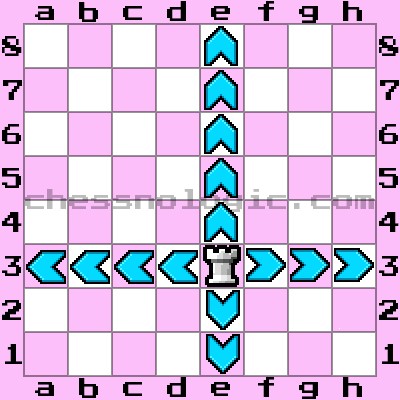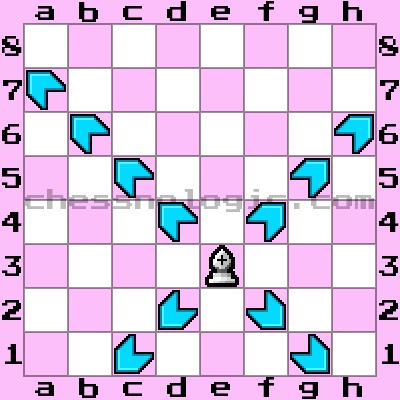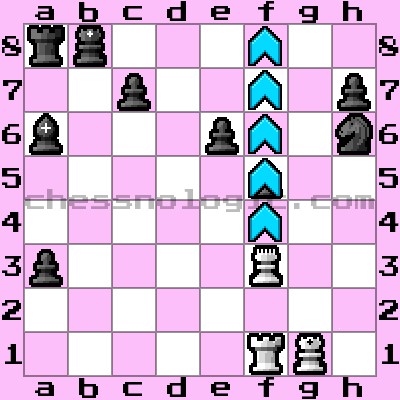If you want to be able to win in chess it is important to understand the movement of the chess pieces. Fortunately within chess this in not too complex but there are some minor tricks that are important to understand in order to use this to your advantage. Let’s go!
King
The King, the most important piece on the board and yet it actually is the most useless of all as well 😅. During the game it is important to prevent a checkmate on your King. With utilizing all pieces you will be likely to do a good job in preventing that however sometimes the king needs to move himself as well. The King is allowed to move in all directions however only 1 square per turn. He is not the fastest of pieces but flexible nevertheless. He is allowed moves horizontally, vertically and diagonally. Capturing other pieces works in the same way as movement. The King moves to a square of its liking, if a piece of the oppontent is on that square, the King will capture that piece.

Queen
The Queen is the most versatile piece on the board. She can move in any direction like the King but all the way to the end of the board if you want. It is not obligated to move the whole end, you can decide how far you want to move your Queen. So she can move horizontally, vertically and diagonally any number of squares you want her to move. Not that you are only allowed to move in 1 single direction during that turn. So you are not allowed to move horizontally followed by a vertical step in the same turn.

Rook
The Rook is an important piece as well. Although not as flexible as the queen it is still one of the stronger pieces. It also has unlimited movement in any of its directions like the Queen but it can only move horizontally and vertically. Again as the Queen in a single turn you can only move in one direction.

Bishop
Similar to the Rook we have the bishop with pretty much the same rules however now it only applies to diagonal movement. The Bishop also have an unlimited amount of squares it can move but again during the turn only in a single direction.

Knight
So the Knight is a bit of a weird piece and a little bit more difficult to master. The reason for that is that the Knight always move in a L shaped way which they can only do once per turn. Which means you have one of the following movement options:
- Move 2 square horizontally and 1 vertically
- Move 1 square horizontally and 2 vertically
- Move 2 quares vertically and 1 horizontally
- Move 1 square vertically and 2 horizontally
On a chessboard the options would look like this:

During your turn the Knight is only allowed to do one of these moves. The is something special about the Knight’s movement and that is that it is the only piece in chess that is allowed to jump over other pieces. It doesn’t matter if they are yours or your oppontents, the Knight can move into any square as long as the square is not occupied by a friendly piece.
Pawn
The Pawn is the foot soldier of the game of chess. They are a swarm of cute little troops or critters and they have limited powers. Pawns only have 1 square movement per turn and that is forward. The little guys and girls just keep moving until they cannot anymore. Examples of this in the below diagram are the Pawns located on square e2 and b3. There are some additional movement rules however. During the setup all pawns are setup on row 2 (white player) and row 7 (black player). If they stand on a square of the original setup, they are allowed in their first move of that piece to take a 2 square movement. Example of this is the Pawn located in square d2.

Capturing another piece is a bit of a different story for Pawns. Although they move forward, they do not capture forward. They are only allowed to capture an enemy piece if they can capture it by making 1 move diagonally forward. Below diagram shows you how that looks for the white players Pawn:

In this particular case you can see that Pawn e2 has 2 options to capture enemy pieces, it can move to d3 or to f3 only if there is an enemy piece. If there are no enemy piece to capture it is only allowed to move forward 1 square. The below diagram show you a real life scenario to clearify more.

In example you see the Pawn in square e4 that basically has 2 options.
- It is allowed to move forward 1 square
- It is allowed to capture the enemy Pawn in square d5.
Difference between moving and capturing
So there is a difference in chess between movement and capturing chess pieces. Something to be aware about is that you are not allowed to capture your own pieces. There is no exception on that. So no matter what you do you are not able to move to a square where one of your pieces is already located. Only the opponent is allowed to do that.
Another thing to realise is that a couple of chess pieces have unlimited movement. However if there is a piece in the way of your movement you are only allowed to move up to the square where your opponent is located and captures that piece taking over the square it occupied. Here is how that would look:

Let’s assume you want to move your Queen from f3 to f8, you would need to pass the pawn in square f5. However that is not allowed in chess.

You are only allowed to move until your piece hits the end of the board, hits one of your own friendly pieces or until you piece captures an opponents piece.

In this case the maximum movement range of the Queen would be up to square f5 and in doing so the Queen captures the f5 Pawn.

And this is how the moment would look like when we execute the maximum movement of the Queen in this scenario.
Now you understand the basic movement of all the chess pieces on the board. Congratulations, you are know ready to get a deeper understanding of chess. Good luck!
